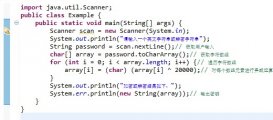1. 類 Executors
Executors類可以看做一個“工具類”。援引JDK1.6 API中的介紹:
此包中所定義的 Executor、ExecutorService、ScheduledExecutorService、ThreadFactory 和 Callable 類的工廠和實用方法。此類支持以下各種方法:
(1)創建并返回設置有常用配置字符串的 ExecutorService 的方法。
(2)創建并返回設置有常用配置字符串的 ScheduledExecutorService 的方法。
(3)創建并返回“包裝的”ExecutorService 方法,它通過使特定于實現的方法不可訪問來禁用重新配置。
(4)創建并返回 ThreadFactory 的方法,它可將新創建的線程設置為已知的狀態。
(5)創建并返回非閉包形式的 Callable 的方法,這樣可將其用于需要 Callable 的執行方法中。
通過這個類能夠獲得多種線程池的實例,例如可以調用newSingleThreadExecutor()獲得單線程的ExecutorService,調 用newFixedThreadPool()獲得固定大小線程池的ExecutorService,等等。拿到ExecutorService可以做的事情就比 較多了,最簡單的是用它來執行Runnable對象,也可以執行一些實現了Callable<T>的對象。用Thread的start()方 法沒有返回值,如果該線程執行的方法有返回值那用ExecutorService就再好不過了,可以選擇submit()、invokeAll()或者 invokeAny(),根據具體情況選擇合適的方法即可。
此類中提供的一些方法有:
1.1 public static ExecutorService newCachedThreadPool()
創建一個可根據需要創建新線程的線程池,但是在以前構造的線程可用時將重用它們。對于執行很多短期異步任務的程序而言,這些線程池通常可提高程序性能。
1.2 public static ExecutorService newFixedThreadPool(int nThreads)
創建一個可重用固定線程數的線程池,以共享的無界隊列方式來運行這些線程。
1.3 public static ExecutorService newSingleThreadExecutor()
創建一個使用單個 worker 線程的 Executor,以無界隊列方式來運行該線程。
這三個方法都可以配合接口ThreadFactory的實例一起使用。并且返回一個ExecutorService接口的實例。
2. 接口 ThreadFactory
根據需要創建新線程的對象。使用線程工廠就無需再手工編寫對 new Thread 的調用了,從而允許應用程序使用特殊的線程子類、屬性等等。
此接口最簡單的實現就是:
|
1
2
3
4
5
|
class SimpleThreadFactory implements ThreadFactory { public Thread newThread(Runnable r) { return new Thread(r); } } |
3. 接口ExecutorService
該接口提供了管理終止的方法。
4.創建標準線程池啟動線程
4.1 提供一個簡單的實現Runnable接口的線程
MyThread.java
|
1
2
3
4
5
6
7
8
9
10
11
12
13
14
15
16
17
18
|
package com.zj.concurrency.executors; public class MyThread implements Runnable { private int count = 1, number; public MyThread(int num) { number = num; System.out.println("Create Thread-" + number); } public void run() { while (true) { System.out.println("Thread-" + number + " run " + count+" time(s)"); if (++count == 3) return; } }} |
這個線程會打印出相應的創建和執行信息。
4.2使用CachedThreadPool啟動線程
CachedThreadPool.java
|
1
2
3
4
5
6
7
8
9
10
11
12
|
package com.zj.concurrency.executors;import java.util.concurrent.ExecutorService;import java.util.concurrent.Executors; public class CachedThreadPool { public static void main(String[] args) { ExecutorService exec = Executors.newCachedThreadPool(); for (int i = 0; i < 5; i++) exec.execute(new MyThread(i)); exec.shutdown(); }} |
結果:
|
1
2
3
4
5
6
7
8
9
10
11
12
13
14
15
|
Create Thread-0Create Thread-1Create Thread-2Create Thread-3Thread-0 run 1 time(s)Thread-0 run 2 time(s)Thread-1 run 1 time(s)Thread-1 run 2 time(s)Thread-2 run 1 time(s)Thread-2 run 2 time(s)Create Thread-4Thread-4 run 1 time(s)Thread-4 run 2 time(s)Thread-3 run 1 time(s)Thread-3 run 2 time(s) |
4.3 使用FixedThreadPool啟動線程
|
1
2
3
4
5
6
7
8
9
10
11
12
13
|
FixedThreadPool.javapackage com.zj.concurrency.executors;import java.util.concurrent.ExecutorService;import java.util.concurrent.Executors; public class FixedThreadPool { public static void main(String[] args) { ExecutorService exec = Executors.newFixedThreadPool(2); for (int i = 0; i < 5; i++) exec.execute(new MyThread(i)); exec.shutdown(); }} |
結果:
|
1
2
3
4
5
6
7
8
9
10
11
12
13
14
15
|
Create Thread-0Create Thread-1Create Thread-2Create Thread-3Create Thread-4Thread-0 run 1 time(s)Thread-0 run 2 time(s)Thread-2 run 1 time(s)Thread-2 run 2 time(s)Thread-3 run 1 time(s)Thread-3 run 2 time(s)Thread-4 run 1 time(s)Thread-4 run 2 time(s)Thread-1 run 1 time(s)Thread-1 run 2 time(s) |
4.4 使用SingleThreadExecutor啟動線程
SingleThreadExecutor.java
|
1
2
3
4
5
6
7
8
9
10
11
12
|
package com.zj.concurrency.executors;import java.util.concurrent.ExecutorService;import java.util.concurrent.Executors; public class SingleThreadExecutor { public static void main(String[] args) { ExecutorService exec = Executors.newSingleThreadExecutor(); for (int i = 0; i < 5; i++) exec.execute(new MyThread(i)); exec.shutdown(); }} |
結果:
|
1
2
3
4
5
6
7
8
9
10
11
12
13
14
15
|
Create Thread-0Create Thread-1Create Thread-2Create Thread-3Create Thread-4Thread-0 run 1 time(s)Thread-0 run 2 time(s)Thread-1 run 1 time(s)Thread-1 run 2 time(s)Thread-2 run 1 time(s)Thread-2 run 2 time(s)Thread-3 run 1 time(s)Thread-3 run 2 time(s)Thread-4 run 1 time(s)Thread-4 run 2 time(s) |
5.配合ThreadFactory接口的使用
我們試圖給線程加入daemon和priority的屬性設置。
5.1設置后臺線程屬性
DaemonThreadFactory.java
|
1
2
3
4
5
6
7
8
9
10
|
package com.zj.concurrency.executors.factory;import java.util.concurrent.ThreadFactory; public class DaemonThreadFactory implements ThreadFactory { public Thread newThread(Runnable r) { Thread t = new Thread(r); t.setDaemon(true); return t; }} |
5.2 設置優先級屬性
最高優先級MaxPriorityThreadFactory.java
|
1
2
3
4
5
6
7
8
9
10
|
package com.zj.concurrency.executors.factory;import java.util.concurrent.ThreadFactory; public class MaxPriorityThreadFactory implements ThreadFactory { public Thread newThread(Runnable r) { Thread t = new Thread(r); t.setPriority(Thread.MAX_PRIORITY); return t; }} |
最低優先級MinPriorityThreadFactory.java
|
1
2
3
4
5
6
7
8
9
10
|
package com.zj.concurrency.executors.factory;import java.util.concurrent.ThreadFactory; public class MinPriorityThreadFactory implements ThreadFactory { public Thread newThread(Runnable r) { Thread t = new Thread(r); t.setPriority(Thread.MIN_PRIORITY); return t; }} |
5.3啟動帶有屬性設置的線程
ExecFromFactory.java
|
1
2
3
4
5
6
7
8
9
10
11
12
13
14
15
16
17
18
19
20
21
22
23
24
25
26
27
|
package com.zj.concurrency.executors;import java.util.concurrent.ExecutorService;import java.util.concurrent.Executors;import com.zj.concurrency.executors.factory.DaemonThreadFactory;import com.zj.concurrency.executors.factory.MaxPriorityThreadFactory;import com.zj.concurrency.executors.factory.MinPriorityThreadFactory; public class ExecFromFactory { public static void main(String[] args) throws Exception { ExecutorService defaultExec = Executors.newCachedThreadPool(); ExecutorService daemonExec = Executors .newCachedThreadPool(new DaemonThreadFactory()); ExecutorService maxPriorityExec = Executors .newCachedThreadPool(new MaxPriorityThreadFactory()); ExecutorService minPriorityExec = Executors .newCachedThreadPool(new MinPriorityThreadFactory()); for (int i = 0; i < 10; i++) daemonExec.execute(new MyThread(i)); for (int i = 10; i < 20; i++) if (i == 10) maxPriorityExec.execute(new MyThread(i)); else if (i == 11) minPriorityExec.execute(new MyThread(i)); else defaultExec.execute(new MyThread(i)); }} |
結果:
|
1
2
3
4
5
6
7
8
9
10
11
12
13
14
15
16
17
18
19
20
21
22
23
24
25
26
27
28
29
30
31
32
33
34
35
36
37
38
39
40
41
42
43
44
45
46
47
48
49
50
51
52
53
54
55
56
57
58
59
60
|
Create Thread-0Create Thread-1Create Thread-2Create Thread-3Thread-0 run 1 time(s)Thread-0 run 2 time(s)Thread-1 run 1 time(s)Thread-1 run 2 time(s)Thread-2 run 1 time(s)Thread-2 run 2 time(s)Create Thread-4Thread-4 run 1 time(s)Thread-4 run 2 time(s)Create Thread-5Thread-5 run 1 time(s)Thread-5 run 2 time(s)Create Thread-6Create Thread-7Thread-7 run 1 time(s)Thread-7 run 2 time(s)Create Thread-8Thread-8 run 1 time(s)Thread-8 run 2 time(s)Create Thread-9Create Thread-10Thread-10 run 1 time(s)Thread-10 run 2 time(s)Create Thread-11Thread-9 run 1 time(s)Thread-9 run 2 time(s)Thread-6 run 1 time(s)Thread-6 run 2 time(s)Thread-3 run 1 time(s)Thread-3 run 2 time(s)Create Thread-12Create Thread-13Create Thread-14Thread-12 run 1 time(s)Thread-12 run 2 time(s)Thread-13 run 1 time(s)Thread-13 run 2 time(s)Create Thread-15Thread-15 run 1 time(s)Thread-15 run 2 time(s)Create Thread-16Thread-16 run 1 time(s)Thread-16 run 2 time(s)Create Thread-17Create Thread-18Create Thread-19Thread-14 run 1 time(s)Thread-14 run 2 time(s)Thread-17 run 1 time(s)Thread-17 run 2 time(s)Thread-18 run 1 time(s)Thread-18 run 2 time(s)Thread-19 run 1 time(s)Thread-19 run 2 time(s)Thread-11 run 1 time(s)Thread-11 run 2 time(s) |

















